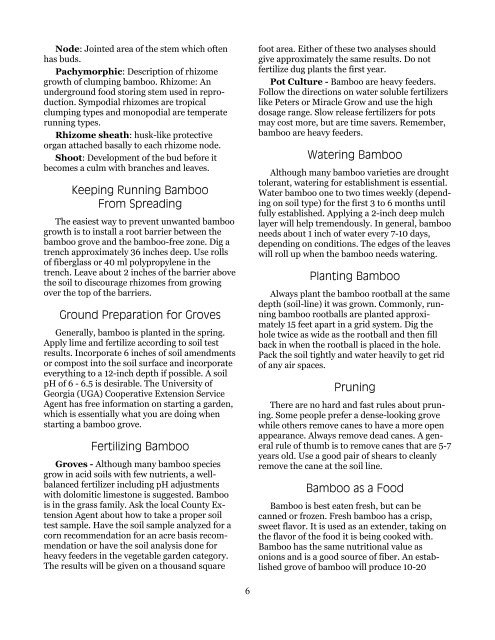Growing Bamboo in Georgia - Orange County Extension Education ...
Growing Bamboo in Georgia - Orange County Extension Education ...
Growing Bamboo in Georgia - Orange County Extension Education ...
You also want an ePaper? Increase the reach of your titles
YUMPU automatically turns print PDFs into web optimized ePapers that Google loves.
Node: Jo<strong>in</strong>ted area of the stem which often<br />
has buds.<br />
Pachymorphic: Description of rhizome<br />
growth of clump<strong>in</strong>g bamboo. Rhizome: An<br />
underground food stor<strong>in</strong>g stem used <strong>in</strong> reproduction.<br />
Sympodial rhizomes are tropical<br />
clump<strong>in</strong>g types and monopodial are temperate<br />
runn<strong>in</strong>g types.<br />
Rhizome sheath: husk-like protective<br />
organ attached basally to each rhizome node.<br />
Shoot: Development of the bud before it<br />
becomes a culm with branches and leaves.<br />
Keep<strong>in</strong>g Runn<strong>in</strong>g <strong>Bamboo</strong><br />
From Spread<strong>in</strong>g<br />
The easiest way to prevent unwanted bamboo<br />
growth is to <strong>in</strong>stall a root barrier between the<br />
bamboo grove and the bamboo-free zone. Dig a<br />
trench approximately 36 <strong>in</strong>ches deep. Use rolls<br />
of fiberglass or 40 ml polypropylene <strong>in</strong> the<br />
trench. Leave about 2 <strong>in</strong>ches of the barrier above<br />
the soil to discourage rhizomes from grow<strong>in</strong>g<br />
over the top of the barriers.<br />
Ground Preparation for Groves<br />
Generally, bamboo is planted <strong>in</strong> the spr<strong>in</strong>g.<br />
Apply lime and fertilize accord<strong>in</strong>g to soil test<br />
results. Incorporate 6 <strong>in</strong>ches of soil amendments<br />
or compost <strong>in</strong>to the soil surface and <strong>in</strong>corporate<br />
everyth<strong>in</strong>g to a 12-<strong>in</strong>ch depth if possible. A soil<br />
pH of 6 - 6.5 is desirable. The University of<br />
<strong>Georgia</strong> (UGA) Cooperative <strong>Extension</strong> Service<br />
Agent has free <strong>in</strong>formation on start<strong>in</strong>g a garden,<br />
which is essentially what you are do<strong>in</strong>g when<br />
start<strong>in</strong>g a bamboo grove.<br />
Fertiliz<strong>in</strong>g <strong>Bamboo</strong><br />
Groves - Although many bamboo species<br />
grow <strong>in</strong> acid soils with few nutrients, a wellbalanced<br />
fertilizer <strong>in</strong>clud<strong>in</strong>g pH adjustments<br />
with dolomitic limestone is suggested. <strong>Bamboo</strong><br />
is <strong>in</strong> the grass family. Ask the local <strong>County</strong> <strong>Extension</strong><br />
Agent about how to take a proper soil<br />
test sample. Have the soil sample analyzed for a<br />
corn recommendation for an acre basis recommendation<br />
or have the soil analysis done for<br />
heavy feeders <strong>in</strong> the vegetable garden category.<br />
The results will be given on a thousand square<br />
6<br />
foot area. Either of these two analyses should<br />
give approximately the same results. Do not<br />
fertilize dug plants the first year.<br />
Pot Culture - <strong>Bamboo</strong> are heavy feeders.<br />
Follow the directions on water soluble fertilizers<br />
like Peters or Miracle Grow and use the high<br />
dosage range. Slow release fertilizers for pots<br />
may cost more, but are time savers. Remember,<br />
bamboo are heavy feeders.<br />
Water<strong>in</strong>g <strong>Bamboo</strong><br />
Although many bamboo varieties are drought<br />
tolerant, water<strong>in</strong>g for establishment is essential.<br />
Water bamboo one to two times weekly (depend<strong>in</strong>g<br />
on soil type) for the first 3 to 6 months until<br />
fully established. Apply<strong>in</strong>g a 2-<strong>in</strong>ch deep mulch<br />
layer will help tremendously. In general, bamboo<br />
needs about 1 <strong>in</strong>ch of water every 7-10 days,<br />
depend<strong>in</strong>g on conditions. The edges of the leaves<br />
will roll up when the bamboo needs water<strong>in</strong>g.<br />
Plant<strong>in</strong>g <strong>Bamboo</strong><br />
Always plant the bamboo rootball at the same<br />
depth (soil-l<strong>in</strong>e) it was grown. Commonly, runn<strong>in</strong>g<br />
bamboo rootballs are planted approximately<br />
15 feet apart <strong>in</strong> a grid system. Dig the<br />
hole twice as wide as the rootball and then fill<br />
back <strong>in</strong> when the rootball is placed <strong>in</strong> the hole.<br />
Pack the soil tightly and water heavily to get rid<br />
of any air spaces.<br />
Prun<strong>in</strong>g<br />
There are no hard and fast rules about prun<strong>in</strong>g.<br />
Some people prefer a dense-look<strong>in</strong>g grove<br />
while others remove canes to have a more open<br />
appearance. Always remove dead canes. A general<br />
rule of thumb is to remove canes that are 5-7<br />
years old. Use a good pair of shears to cleanly<br />
remove the cane at the soil l<strong>in</strong>e.<br />
<strong>Bamboo</strong> as a Food<br />
<strong>Bamboo</strong> is best eaten fresh, but can be<br />
canned or frozen. Fresh bamboo has a crisp,<br />
sweet flavor. It is used as an extender, tak<strong>in</strong>g on<br />
the flavor of the food it is be<strong>in</strong>g cooked with.<br />
<strong>Bamboo</strong> has the same nutritional value as<br />
onions and is a good source of fiber. An established<br />
grove of bamboo will produce 10-20
















